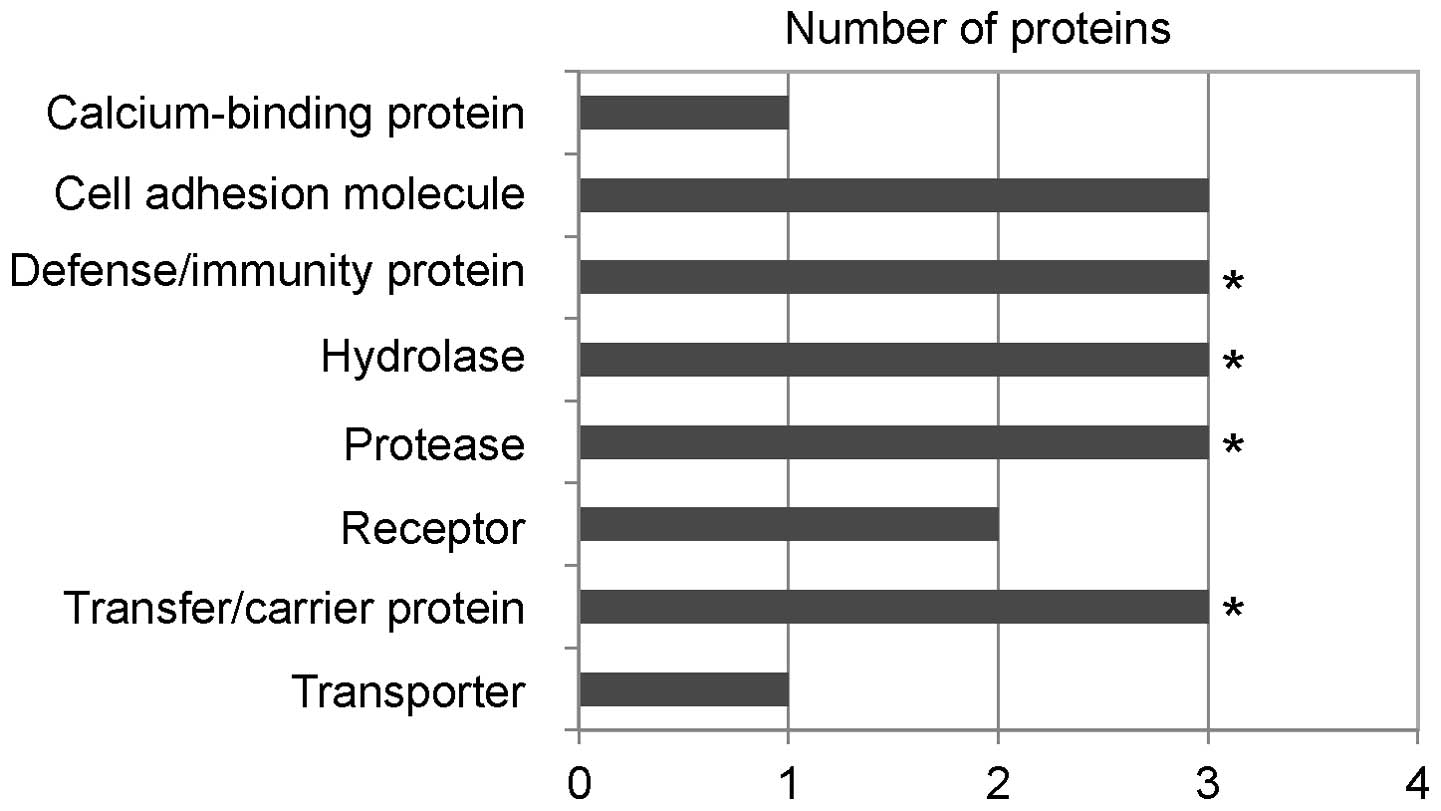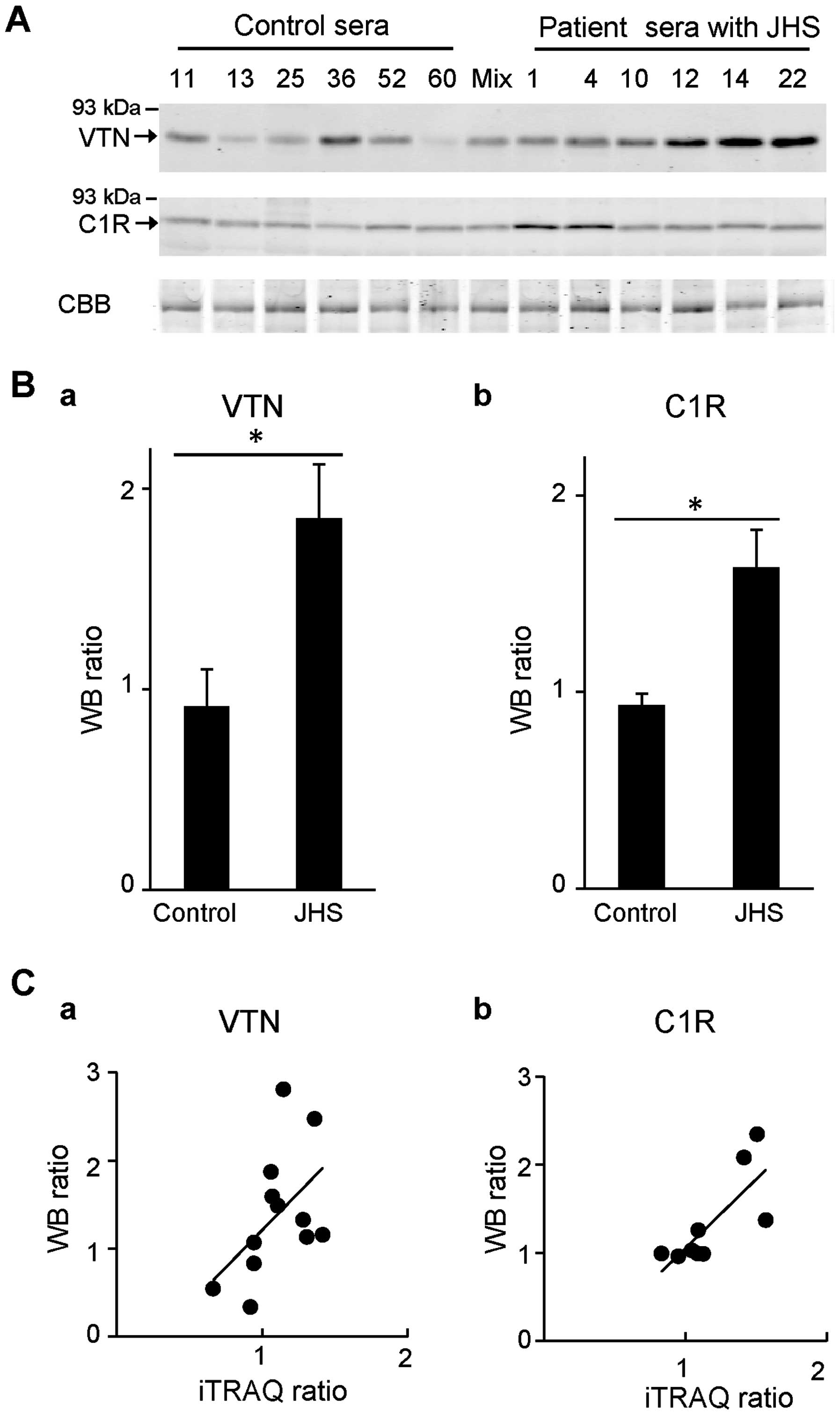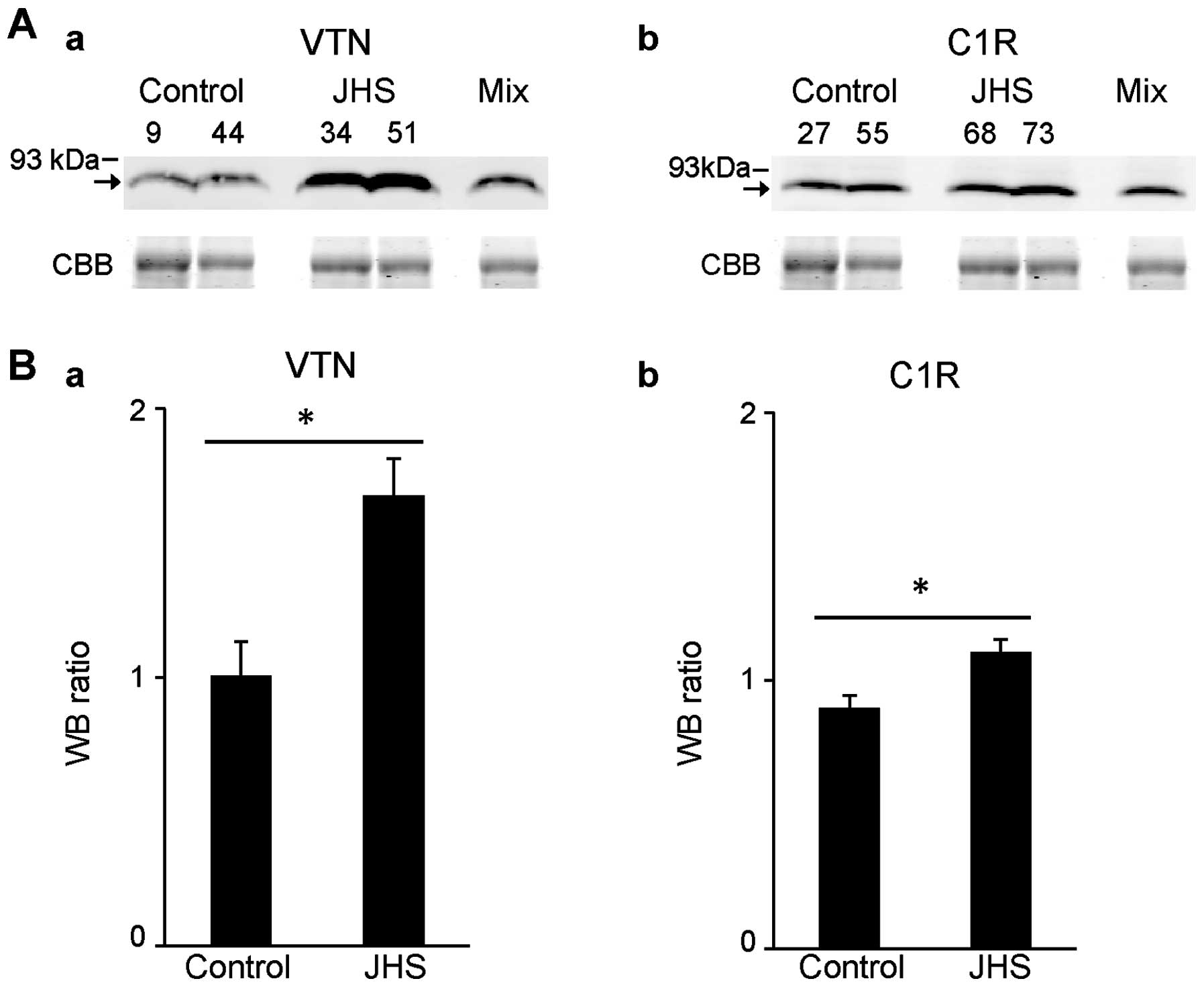|
1
|
Grahame R: Joint hypermobility and genetic
collagen disorders: are they related? Arch Dis Child. 80:188–191.
1999. View Article : Google Scholar : PubMed/NCBI
|
|
2
|
Malfait F, Hakim AJ, De Paepe A and
Grahame R: The genetic basis of the joint hypermobility syndromes.
Rheumatology (Oxford). 45:502–507. 2006. View Article : Google Scholar
|
|
3
|
Castori M, Morlino S, Celletti C,
Ghibellini G, Bruschini M, Grammatico P, Blundo C and Camerota F:
Re-writing the natural history of pain and related symptoms in the
joint hypermobility syndrome/Ehlers-Danlos syndrome, hypermobility
type. Am J Med Genet A. 161A:2989–3004. 2013. View Article : Google Scholar : PubMed/NCBI
|
|
4
|
Tinkle BT, Bird HA, Grahame R, Lavallee M,
Levy HP and Sillence D: The lack of clinical distinction between
the hypermobility type of Ehlers-Danlos syndrome and the joint
hypermobility syndrome (a.k.a. hypermobility syndrome). Am J Med
Genet A. 149A:2368–2370. 2009. View Article : Google Scholar : PubMed/NCBI
|
|
5
|
Zweers MC, Bristow J, Steijlen PM, Dean
WB, Hamel BC, Otero M, Kucharekova M, Boezeman JB and Schalkwijk J:
Haploinsufficiency of TNXB is associated with hypermobility type of
Ehlers-Danlos syndrome. Am J Hum Genet. 73:214–217. 2003.
View Article : Google Scholar : PubMed/NCBI
|
|
6
|
Beighton P: Hypermobility scoring. Br J
Rheumatol. 27:1631988. View Article : Google Scholar : PubMed/NCBI
|
|
7
|
Grahame R, Bird HA and Child A: The
revised (Brighton 1998) criteria for the diagnosis of benign joint
hypermobility syndrome (BJHS). J Rheumatol. 27:1777–1779.
2000.PubMed/NCBI
|
|
8
|
Sutton CW, Rustogi N, Gurkan C, Scally A,
Loizidou MA, Hadjisavvas A and Kyriacou K: Quantitative proteomic
profiling of matched normal and tumor breast tissues. J Proteome
Res. 9:3891–3902. 2010. View Article : Google Scholar : PubMed/NCBI
|
|
9
|
Bijian K, Mlynarek AM, Balys RL, Jie S, Xu
Y, Hier MP, Black MJ, Di Falco MR, LaBoissiere S and Alaoui-Jamali
MA: Serum proteomic approach for the identification of serum
biomarkers contributed by oral squamous cell carcinoma and host
tissue microenvironment. J Proteome Res. 8:2173–2185. 2009.
View Article : Google Scholar : PubMed/NCBI
|
|
10
|
Ross PL, Huang YN, Marchese JN, Williamson
B, Parker K, Hattan S, Khainovski N, Pillai S, Dey S, Daniels S, et
al: Multiplexed protein quantitation in Saccharomyces cerevisiae
using amine-reactive isobaric tagging reagents. Mol Cell
Proteomics. 3:1154–1169. 2004. View Article : Google Scholar : PubMed/NCBI
|
|
11
|
Matsumoto K, Satoh K, Maniwa T, Araki A,
Maruyama R and Oda T: Noticeable decreased expression of tenascin-X
in calcific aortic valves. Connect Tissue Res. 53:460–468. 2012.
View Article : Google Scholar : PubMed/NCBI
|
|
12
|
Matsumoto K, Satoh K, Maniwa T, Tanaka T,
Okunishi H and Oda T: Proteomic comparison between abdominal and
thoracic aortic aneurysms. Int J Mol Med. 33:1035–1047.
2014.PubMed/NCBI
|
|
13
|
Satoh K, Maniwa T, Oda T and Matsumoto K:
Proteomic profiling for the identification of serum diagnostic
biomarkers for abdominal and thoracic aortic aneurysms. Proteome
Sci. 11:272013. View Article : Google Scholar : PubMed/NCBI
|
|
14
|
Beighton P, De Paepe A, Steinmann B,
Tsipouras P and Wenstrup RJ: Ehlers-Danlos syndromes: revised
nosology, Villefranche, 1997. Ehlers-Danlos National Foundation
(USA) and Ehlers-Danlos Support Group (UK). Am J Med Genet.
77:31–37. 1998. View Article : Google Scholar : PubMed/NCBI
|
|
15
|
Levy HP: Ehlers-Danlos Syndrome,
Hypermobility Type. Gene-Reviews (Internet). Pagon RA, Adam MP,
Ardinger HH, et al: Last Update: September 13, 2012. University of
Washington; Seattle: 1993–2015
|
|
16
|
Shilov IV, Seymour SL, Patel AA, Loboda A,
Tang WH, Keating SP, Hunter CL, Nuwaysir LM and Schaeffer DA: The
Paragon Algorithm, a next generation search engine that uses
sequence temperature values and feature probabilities to identify
peptides from tandem mass spectra. Mol Cell Proteomics.
6:1638–1655. 2007. View Article : Google Scholar : PubMed/NCBI
|
|
17
|
Mi H, Muruganujan A and Thomas PD: PANTHER
in 2013: modeling the evolution of gene function, and other gene
attributes, in the context of phylogenetic trees. Nucleic Acids
Res. 41:D377–D386. 2013. View Article : Google Scholar :
|
|
18
|
Nakamura Y, Takayama N, Minamitani T,
Ikuta T, Ariga H and Matsumoto K: Primary structure, genomic
organization and expression of the major secretory protein of
murine epididymis, ME1. Gene. 251:55–62. 2000. View Article : Google Scholar : PubMed/NCBI
|
|
19
|
Podack ER and Müller-Eberhard HJ:
Isolation of human S-protein, an inhibitor of the membrane attack
complex of complement. J Biol Chem. 254:9808–9814. 1979.PubMed/NCBI
|
|
20
|
Markiewski MM and Lambris JD: The role of
complement in inflammatory diseases from behind the scenes into the
spotlight. Am J Pathol. 171:715–727. 2007. View Article : Google Scholar : PubMed/NCBI
|
|
21
|
Mizuno M: A review of current knowledge of
the complement system and the therapeutic opportunities in
inflammatory arthritis. Curr Med Chem. 13:1707–1717. 2006.
View Article : Google Scholar : PubMed/NCBI
|
|
22
|
Breitner S, Störkel S, Reichel W and Loos
M: Complement components C1q, C1r/C1s, and C1INH in rheumatoid
arthritis. Correlation of in situ hybridization and northern blot
results with function and protein concentration in synovium and
primary cell cultures. Arthritis Rheum. 38:492–498. 1995.
View Article : Google Scholar : PubMed/NCBI
|
|
23
|
Milis L, Morris CA, Sheehan MC,
Charlesworth JA and Pussell BA: Vitronectin-mediated inhibition of
complement: evidence for different binding sites for C5b-7 and C9.
Clin Exp Immunol. 92:114–119. 1993. View Article : Google Scholar : PubMed/NCBI
|
|
24
|
Konttinen YT, Ceponis A, Meri S,
Vuorikoski A, Kortekangas P, Sorsa T, Sukura A and Santavirta S:
Complement in acute and chronic arthritides: assessment of C3c, C9,
and protectin (CD59) in synovial membrane. Ann Rheum Dis.
55:888–894. 1996. View Article : Google Scholar : PubMed/NCBI
|
|
25
|
Blom AM, Villoutreix BO and Dahlbäck B:
Complement inhibitor C4b-binding protein-friend or foe in the
innate immune system? Mol Immunol. 40:1333–1346. 2004. View Article : Google Scholar : PubMed/NCBI
|
|
26
|
Olivar R, Luque A, Naranjo-Gómez M, Quer
J, García de Frutos P, Borràs FE, Rodríguez de Córdoba S, Blom AM
and Aran JM: The α7β0 isoform of the complement regulator
C4b-binding protein induces a semimature, anti-inflammatory state
in dendritic cells. J Immunol. 190:2857–2872. 2013. View Article : Google Scholar : PubMed/NCBI
|
|
27
|
Coutaux A, Adam F, Willer JC and Le Bars
D: Hyperalgesia and allodynia: peripheral mechanisms. Joint Bone
Spine. 72:359–371. 2005. View Article : Google Scholar : PubMed/NCBI
|
|
28
|
Jang JH, Liang D, Kido K, Sun Y, Clark DJ
and Brennan TJ: Increased local concentration of complement C5a
contributes to incisional pain in mice. J Neuroinflammation.
8:802011. View Article : Google Scholar : PubMed/NCBI
|
|
29
|
Jang JH, Clark JD, Li X, Yorek MS, Usachev
YM and Brennan TJ: Nociceptive sensitization by complement C5a and
C3a in mouse. Pain. 148:343–352. 2010. View Article : Google Scholar :
|
|
30
|
Thompson A and Danesh J: Associations
between apolipoprotein B, apolipoprotein AI, the apolipoprotein
B/AI ratio and coronary heart disease: a literature-based
meta-analysis of prospective studies. J Intern Med. 259:481–492.
2006. View Article : Google Scholar : PubMed/NCBI
|
|
31
|
Sánchez-Enríquez S, Torres-Carrillo NM,
Vázquez-Del Mercado M, Salgado-Goytia L, Rangel-Villalobos H and
Muñoz-Valle JF: Increase levels of apo-A1 and apo B are associated
in knee osteoarthritis: lack of association with VEGF-460 T/C and
+405 C/G polymorphisms. Rheumatol Int. 29:63–68. 2008. View Article : Google Scholar : PubMed/NCBI
|
|
32
|
Wilson GN: Exome analysis of connective
tissue dysplasia: death and rebirth of clinical genetics? Am J Med
Genet A. 164A:1209–1212. 2014. View Article : Google Scholar : PubMed/NCBI
|

















